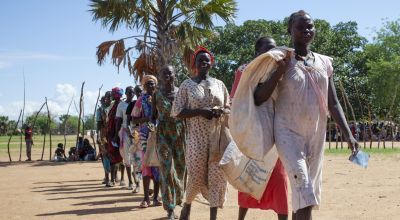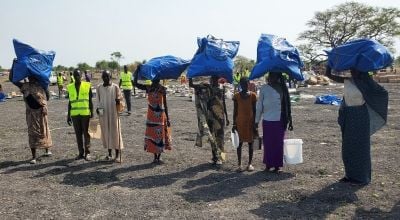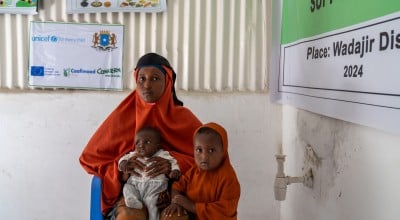
Read our 2024 annual report

Knowledge Hub
Whatever your beliefs, it’s telling that two of the four horsemen of the apocalypse are war and famine. In 2023, both are existential threats for tens of millions of people around the world.
In 2018, the UN Security Council formally acknowledged the link between conflict and hunger, as well as the use of hunger as a weapon of war. Resolution 2417 prioritised “the need to break the vicious cycle between armed conflict and hunger, establishing accountability for those who exploit starvation for their own ends.”
Five years later, more countries are at war and more people are facing famine. These two facts aren’t coincidental, and they’re part of a historical pattern.
Here’s what you need to know about the link between famine and war.
How is hunger a weapon of war?
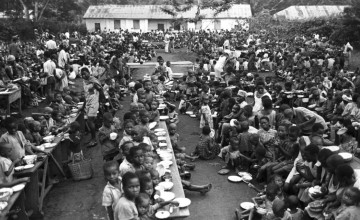
In many contexts, hunger can lead to war. A lack of crucial resources leads to tensions that can easily spiral out of control, especially when shortages are politicised.
In some cases, however, hunger is deliberately used as a weapon of war, meaning that faction leaders exploit food shortages, hunger, and even famine for their own gain. In 1967, when the territory of Biafra declared independence from Nigeria, Nigerian troops cut off food from reaching the 13 million people in the eastern territory, deliberately starving civilians to death - as many as 10,000 people a day. (This was the famine that led to the launch of Concern.)
This is not a modern tactic; Sun Tzu even writes of starvation as a military tactic in his 5th Century (BC) text, The Art of War. As the humanitarian rights watchdog Global Rights Compliance explains, the popularisation of siege warfare in the Middle Ages and Zulu leader Shaka’s scorched earth policy of the Ndwandwe-Zulu War in the early 1800s are two key developments in this history. Siege warfare meant that a targeted area was cut off from aid or supplies; scorched earth meant that one faction would destroy the resources of a village as they left, leaving nothing for survivors.
» Related: Learn more about the links between conflict and hunger.
Why famine?
Famine is an extreme version of using hunger as a weapon of war, and takes place when a substantial percentage of a country’s (or region’s) population are unable to get sufficient food. The UN measures hunger levels according to the Integrated Food Security Phase Classification (IPC), Phase 5 of which being famine. Phase 5 takes place when:
- 20% of a population suffers extreme food shortages
- 30% of children under the age of five suffer acute malnutrition
- The death rate of an area has doubled, or two people (or four children) out of every 10,000 people die each day
This is what happened in Biafra in 1967. Hunger in general - and famine in particular - is a sure way of weakening a population. The effects of hunger are well-documented and practically unavoidable, and leave armies weakened and civilians pushing for resolution, regardless of the terms of surrender.
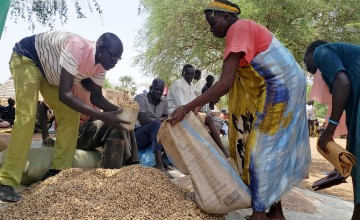
Isn’t it illegal to starve civilians?
Yes. In 1977, two protocols were added to the Geneva Conventions, which set the humanitarian and legal standards for people during wartime. These protocols specifically prohibit starvation as a war tactic, as well as the destruction of crops, water points, and other pieces of infrastructure critical to human life.
In some cases, however, these protocols have been deliberately ignored - such as the Cambodian Civil War of the late 1970s, during which time the Khmer Rouge blocked humanitarian groups like UNICEF, the WFP, and the IRC from delivering emergency food rations to key areas.
In other instances, famine or starvation may not be a deliberate goal, but it is still the net effect. The 16-year Mozambican Civil War resulted in two famines in the 1980s. A 1992 Human Rights Watch report didn’t directly blame the war’s military strategies and human rights violations for these famines, despite there being a clear connection between the two events.

Impact versus intent
It’s not always easy to prove whether a famine was deliberately set up as a war tactic, but in some ways this is secondary to the most important part of this connection: Whether deliberate or not, the end result is the same.
People die - especially children, the elderly, and others who are especially vulnerable to the effects of hunger.
Many of the causes of famine are also linked to conflict. High food prices are often the result of inflation and/or shortages in a region. One World Food Programme report from 2020 showed that people in South Sudan would have to spend 186% of their daily salary on ingredients for a basic meal. In Ireland, that would be roughly equivalent to spending €250 on a plate of rice and beans.

Often, humanitarian organisations are also prevented from accessing the hardest-to-reach - and most vulnerable - areas of a conflict, including remote communities and places on or close to the frontlines. In some cases, this is due to road closures or other forms of damaged infrastructure. In other cases, however, food aid is halted by officials because the humanitarian mandate cannot be fulfilled.
Famine and war: How do we end both?
The Stockholm International Peace Research Institute (SIPRI) identified 56 countries experiencing some form of conflict (either local or national) in 2023 - nearly a 10% increase compared to 2021.
Ultimately, each of these conflicts need to be addressed and moved towards a sustainable peace in order to effectively reduce the chances of famines occurring in the future. But this on its own is not enough.
The more that conflict spreads, the more compromised local systems of infrastructure and governance become, and the longer the recovery process will be.
A cycle of crisis in Somalia can be attributed to a decades-long civil war. More than a decade of fighting in Syria has all but destroyed its middle class and public works. Despite several peace treaties, the crisis in South Sudan has yet to reach a true ceasefire.

SIPRI identifies a few key actions to break the link between conflict and famine and foster a lasting peace.
Sharing access to contested natural resources
Debates over land and water ownership or access are some of the most common origins to conflicts. Sustainably ending these conflicts will mean finding ways of sharing access to these resources and finding other solutions for communities to have what they need. This is especially important with the effects of climate change forcing displacement and depleting resources independently of conflict.
Increasing social cohesion and community-based resolutions
Overall, social cohesion needs to be fostered in order for communities to rebuild. We saw this after the end of the Sierra Leonean Civil War: Peacekeeping could have fallen apart in such a small country with many people knowing friends, neighbours, or family members who fought on opposing sides. Transitional justice tactics were employed including the establishment of a Special Court to try high-ranking commanders and the Sierra Leone Truth and Reconciliation Commission to help foster restorative justice among civilians and former soldiers. The effects haven’t been perfect, but Sierra Leone has maintained peace for more than two decades.

Promoting opportunity and inclusion, especially for youth
In general, citizens must take part in their peace-building process, especially citizens who aren’t always included in decision-making processes. For example, when women are witnesses, signatories, mediators, and/or negotiators in a peace process, the agreement is 20% more likely to last at least two years. Many communities and groups of people will need more than representation after a ceasefire, particularly young people who are more likely to be affected by war. Livelihoods, education, and equity are all key elements of the peace-building and peace-keeping process.
Rebuilding trust between citizens and governments
Ultimately conflict and hunger are both the effects of poor governance, and ongoing distrust will undermine efforts to end both.

Famine and war: Concern’s response
When conflict hits, Concern seeks out the most-affected and hardest-to-reach communities to meet their immediate needs. We also work with them to design innovative, fast, and effective responses that fit both long- and short-term scenarios.
In places that host internally-displaced civilians or refugees, we help to ensure that people forced to leave home have the support they need, while also working with host communities to ensure that they also have enough resources.



